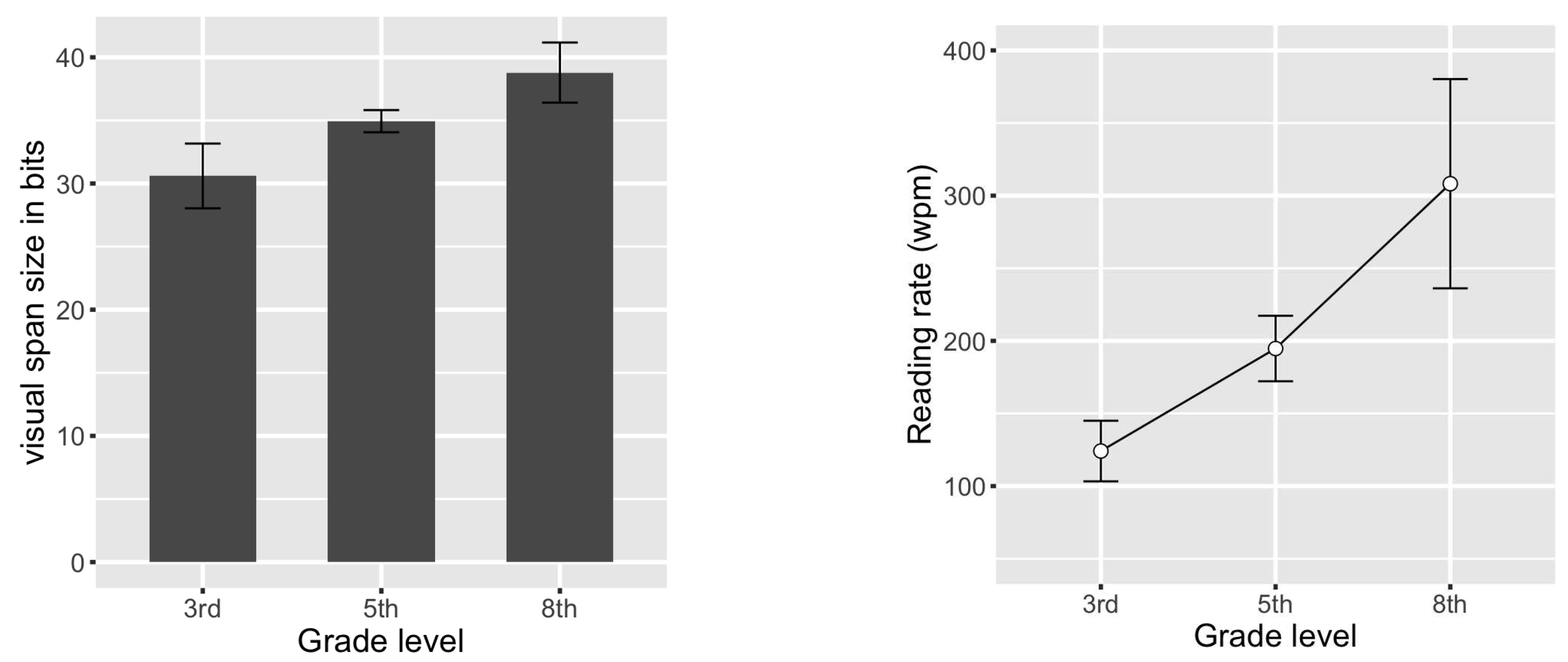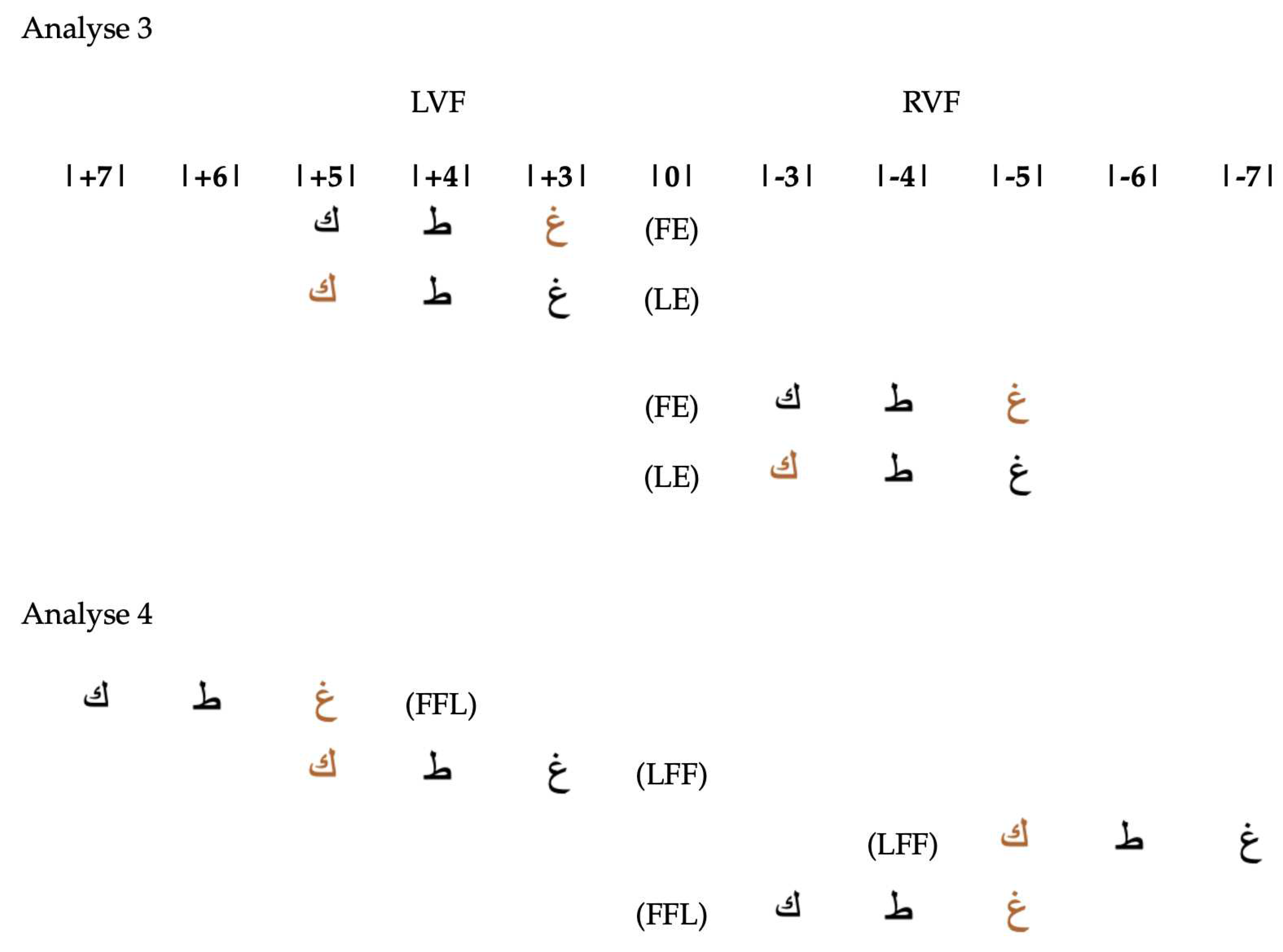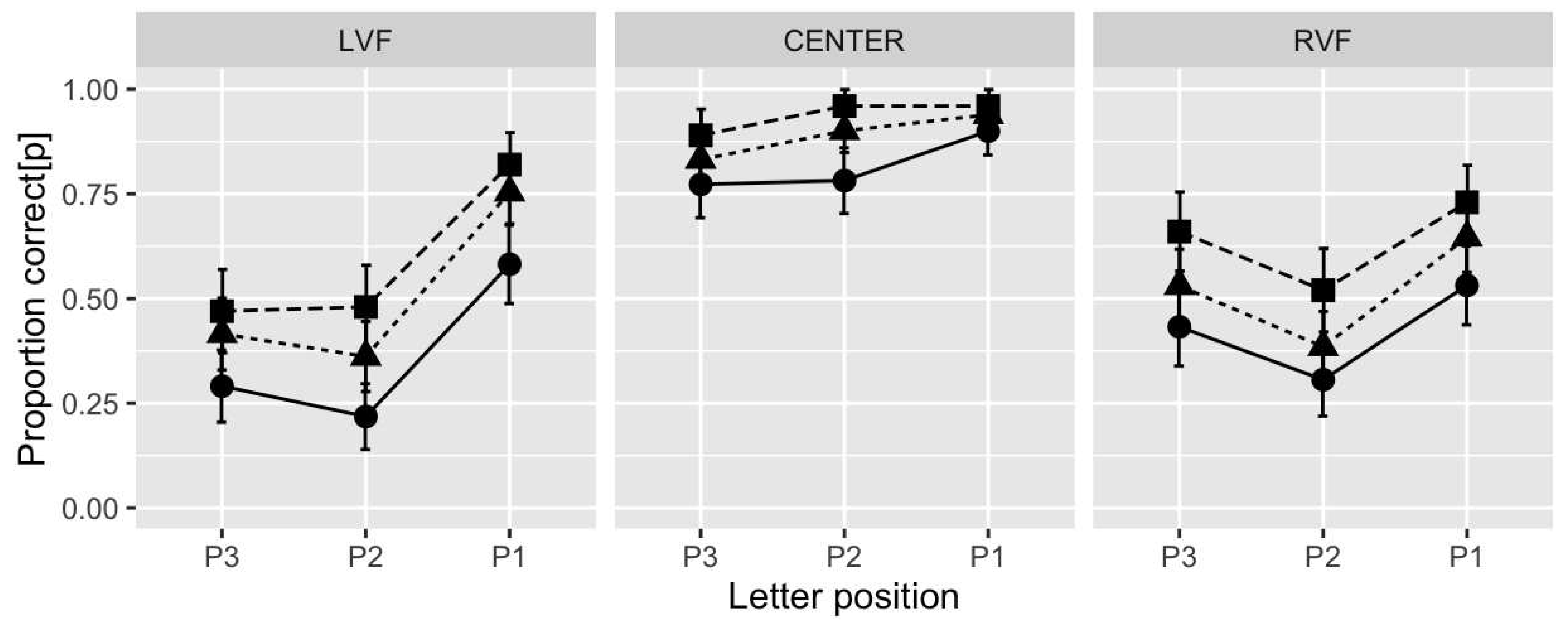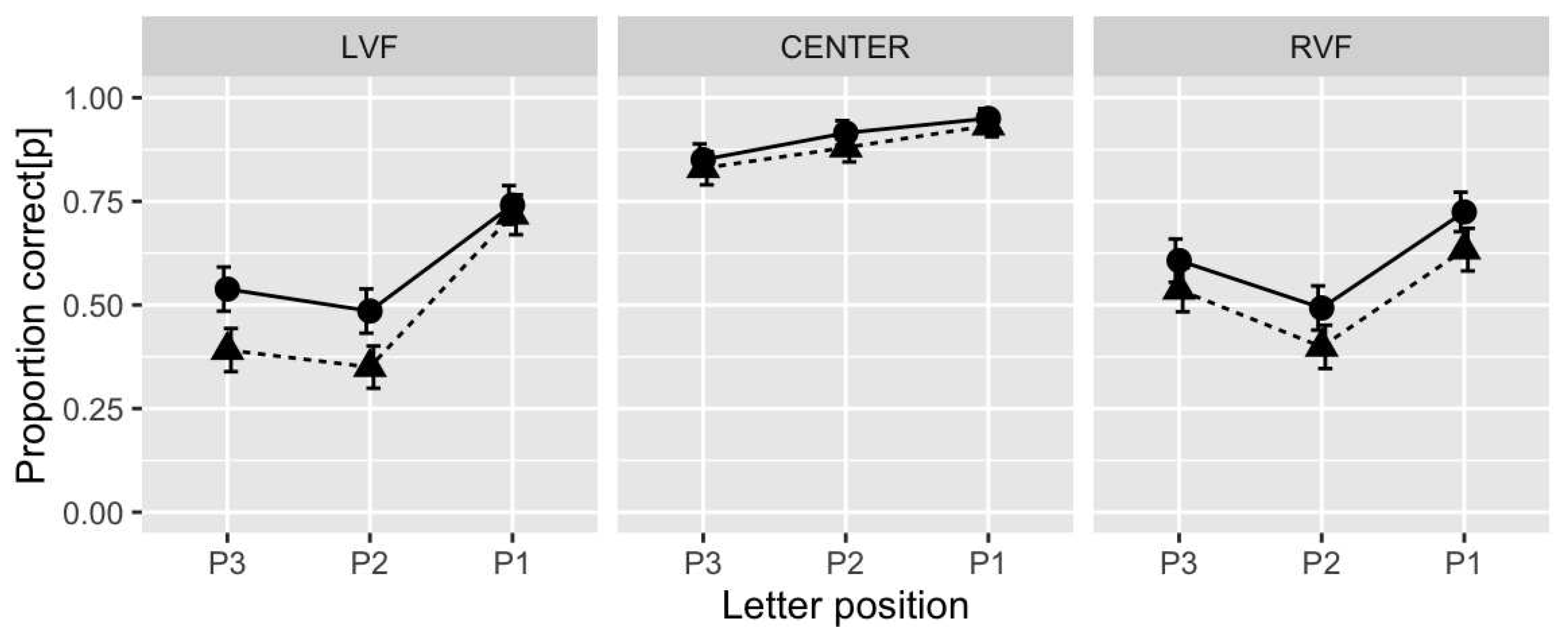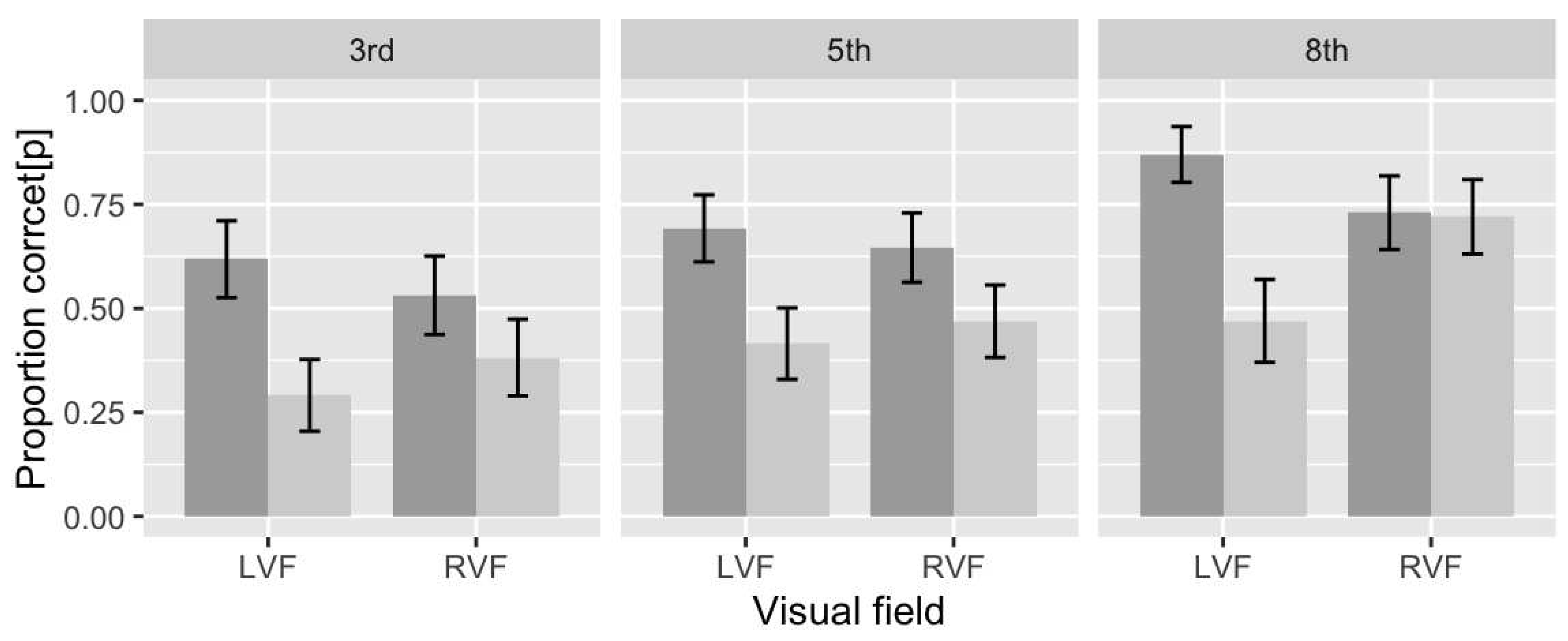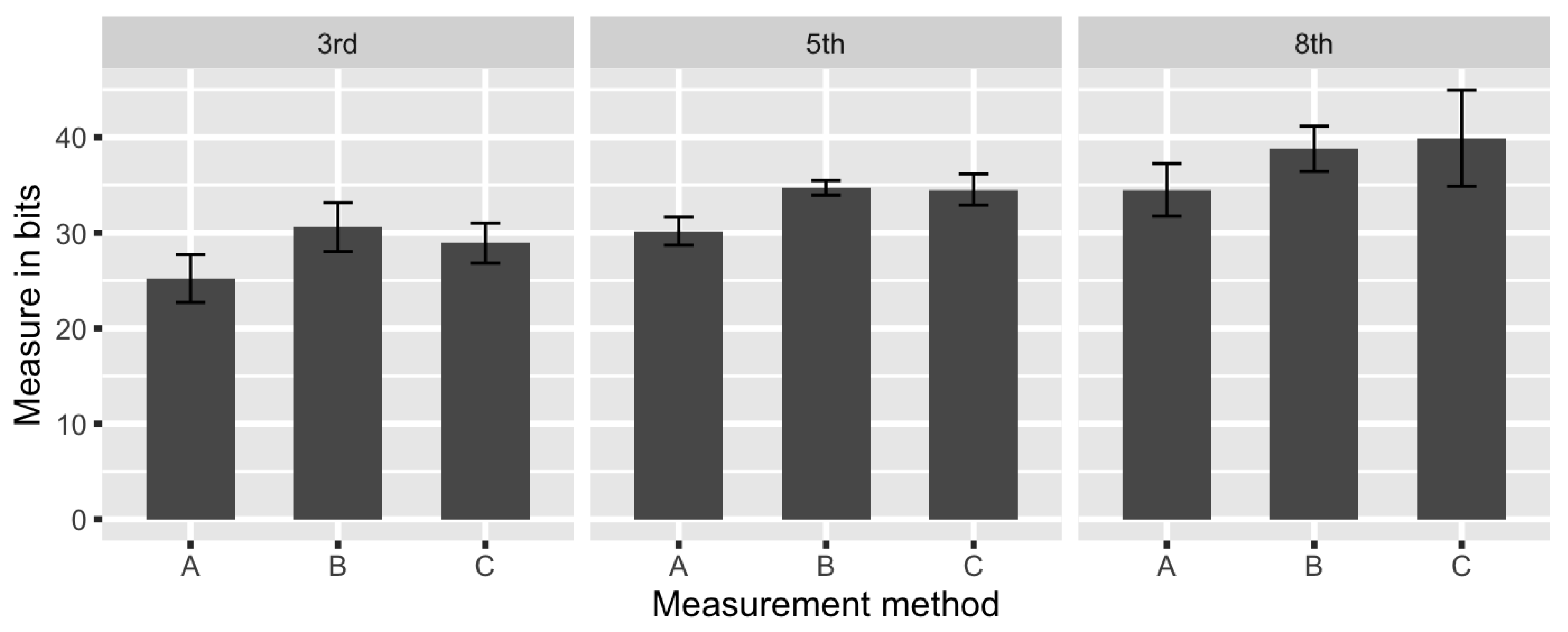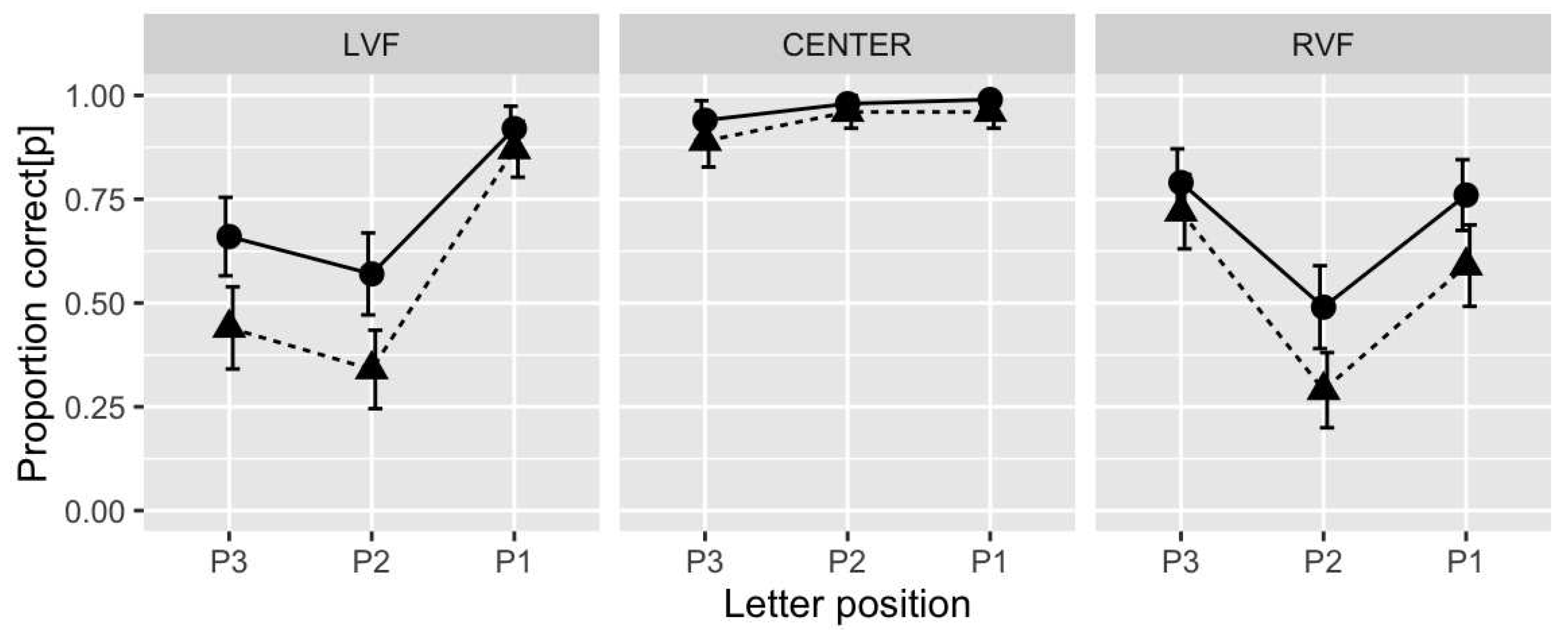5.2.1. Analysis 1: Effects of grade level, trigram position and letter position in the trigram
A General Linear Mixed Effect Model (GLMM) using the glmer function(R Core Team, 2020) with grade level (3rd vs. 5th vs. 8th) and letter position within the trigram (P1, P2, P3) as fixed effects and the participants as random effect show significant effects of grade level (
) and letter position within the trigram (
). Pairwise comparisons showed a significant difference in performance between the third and eighth levels (Estimate=-0.623, SE=0.287, z= -2.175 ). On the other hand, the analyses revealed no significant difference in performance between the eighth and fifth levels (Estimate= -0.673, SE= 0.373, z=-1.804) and between the fifth and third levels (Estimate= -1.259, SE= 0.371, z= -3.392). Regarding the position effect, Pairwise comparisons suggest that the letter occupying position P1 was better recognized than those occupying positions P2 (Estimate=0.665, SE=0.276, z= 2.408) and P3 (Estimate=1.097, SE=0.264, z=4.153). No significant difference in performance was found between positions P2 and P3 (Estimate=0.431, SE=0.226, z= 1.913). Contrast analyses using the Tukey method were reported (see
Table 4)
Table 4.
Parameters of the pairwise comparisons conducted across the three letter positions (P1, P2, P3) of the median trigram separately for the third, fifth, and eight grade levels
Table 4.
Parameters of the pairwise comparisons conducted across the three letter positions (P1, P2, P3) of the median trigram separately for the third, fifth, and eight grade levels
| Third grade(3rd) |
Fifth grade (5th) |
Eight grade (8th) |
| Letter pos |
Estimate |
SE |
z |
Estimate |
SE |
z |
Estimate |
SE |
z |
| P1 - P2 |
0.972 |
0.400 |
2.431 |
0.527 |
0.467 |
1.127 |
0.001 |
0.735 |
0.000 |
| P1 - P3 |
1.028 |
0.398 |
2.584 |
1.132 |
0.433 |
2.613 |
0.001 |
0.619 |
1.860 |
| P2 - P3 |
0.056 |
0.333 |
0.169 |
0.605 |
0.374 |
1.618 |
0.001 |
0.619 |
1.860 |
A general linear mixed effects model (GLMMs), using the glmer function (R Core Team, 2020) with grade level (3rd vs. 5th vs. 8th), visual field (LVF vs. RVF), and letter position (P1 vs. P2 vs. P3) as fixed effects, and participants as a random effect, shows significant effects of grade level (), letter position in the trigram (), and the interaction between position and visual field(). No significant effect of the visual field was found (). Subjects in the eighth level performed better than those in the fifth (Estimate= -0.439, SE= 0.153, z=-2.862). Similarly, a significant difference was found between the third and fifth levels (Estimate=-0.543, SE=0.149, z= -3.639).
Figure 5.
Proportion correct as a function of grade level (3rd, 5th and 8th), visual field (CENTER, LVF and RVF) and letter position in trigrams. Edges, triangles and squares represent eight (8th), fifth (5th) and third (3rd) grade levels, respectively
Figure 5.
Proportion correct as a function of grade level (3rd, 5th and 8th), visual field (CENTER, LVF and RVF) and letter position in trigrams. Edges, triangles and squares represent eight (8th), fifth (5th) and third (3rd) grade levels, respectively
The decomposition of the interaction effect by contrast analysis using the Tukey method shows that at the right visual field (RVF) level, the differences in performance were significant between the three positions (P1, P2, P3). On the other hand, at the level of the left visual field (LVF), the analyses suggest that only the differences between positions P1 and P2 (Estimate=1.642, SE=0.172, z=9.525) and between positions P1 and P3 (Estimate=-1.455, SE=0.170, z=8.551), were significant. No significant difference was revealed between positions P2 and P3 (Estimate=-0.186, SE=0.163, z=-1.142). Contrast analyses using the Tukey method were reported (see
Table 5).
5.2.2. Analysis 2: Visual acuity, crowding, attention and memory
A General Linear Mixed Effects Model (GLMM), using glmer function (R Core Team, 2020), recall type (FR v.s SR), and visual field (CENTER vs. LVF vs. RVF) as fixed effects, and participants as a random effect, shows an effect of visual field (
), and report type (
). At the level of central vision (CENTER), no significant difference was found between the scores obtained from the two types of report (FR and SR) (Estimate= 0.273, SE=0.146, z= 1.867). On the other hand, significant differences between the (FR) and (SR) scores were found in the right (RVF) (Estimate= 0.375, SE= 0.093, z= 4.025) and left (LVF) visual fields (Estimate= 0.444, SE= 0.092, z= 4.783). Our analyses also suggest that performance at the central vision level (CENTER) was better than that found at the left visual field (LVF) (Estimate= 2.073, SE= 0.086, z= 23.95) and right visual field (RVF) (Estimate= 1.95, SE= 0.086, z= 22.53). No difference was revealed in performance between the left (LVF) and right visual field (RVF) (Estimate= -0.123, SE= 0.065, z= -1.89). Pairwise comparisons between the performances obtained from the two measures (FR and SR), separately for each of the positions (P2, P2, and P3), were also reported (see
Table 6).
Figure 6.
Proportion correct as a function of visual field (CENTER, LVF and RVF) and recall type. Edges, triangles represent free recall (FR) and serial recall (SR), respectively
Figure 6.
Proportion correct as a function of visual field (CENTER, LVF and RVF) and recall type. Edges, triangles represent free recall (FR) and serial recall (SR), respectively
5.2.4. Analysis 4 : The first letter advantage
A General Linear Mixed Effects Model (GLMM), using the glmer function (R Core Team, 2020) with grade level (3rd vs. 5th vs. 8th), masking condition (LFF vs. FFL), and visual field (LVF vs. RVF) as fixed effects, and participants as a random effect, shows an effect of grade level (
), masking condition (
), and an interaction between masking condition and visual field (
). No effect of the visual field was found (
). The performance of the eighth-level subjects was better than the fifth level (Estimate= -0.657, SE= 0.183, z= -3.59) and the third level (Estimate= -1.091, SE= 0.190, z= -5.742). The performance of the fifth-level subjects was superior to that of the third level (Estimate= -0.433, SE= 0.173, z= -2.505). The decomposition of the interaction effect using pairwise comparisons was also reported (see
Table 8).
Figure 7.
Proportion correct for the target letter in the tree condition. Gray and light Gray bars correpsond to FFL condition (flanked on the left side) and LFF condition (flanked on the right side). Error bars indicate 95% confidence intervals.
Figure 7.
Proportion correct for the target letter in the tree condition. Gray and light Gray bars correpsond to FFL condition (flanked on the left side) and LFF condition (flanked on the right side). Error bars indicate 95% confidence intervals.
5.2.5. Analysis 5: Comparison between measurement methods
A linear mixed effects model (LMM), using the lmer function (R Core Team, 2020) with grade level (3rd vs. 5th vs. 8th) and measurement method (A vs. B vs. C) as fixed effects and participants as a random effect, shows significant effects of grade level (), measurement method (). For grade, all pairwise comparisons were significant (t>1.96). For the measurement method, all pairwise comparisons were significant (t>1.96), except between methods (B) and (C) (Estimate=0.285, SE=0.551, t=0.863).
Figure 8.
Measure in bits as a function of measurement method (A, B and C) and grade level (3rd, 5th and 8th). Error bars indicate 95% confidence intervals.
Figure 8.
Measure in bits as a function of measurement method (A, B and C) and grade level (3rd, 5th and 8th). Error bars indicate 95% confidence intervals.
Table 9.
Measure as function of grade level and measurement method
Table 9.
Measure as function of grade level and measurement method
| Measurement method |
Third grade |
Fifth grade |
Eight grade |
| |
Mean(SD) |
Mean(SD) |
Mean(SD) |
| Method A |
25.19 (3.72) bits |
30.17 (2.43) bits |
34.49 (3.85) bits |
| Method B |
30.59 (3.81) bits |
34.69 (2.27) bits |
38.79 (3.32) bits |
| Method C |
28.91 (3.12) bits |
34.52 (2.69) bits |
39.90 (7.03) bits |
5.2.6. Discussion
In this study, we focused on participants’ performance at the level of central vision (central trigram presented in the 0° position) and the right (RVF) and left (LVF) parafoveal regions (trigrams presented in positions +4/-4). Although the trigram task was designed to eliminate high-level influences [
4,
6], the results point to a decrease in the recall rate at the final position (P3) compared to that obtained at the initial position (P1), at the central vision (CENTER) (see
Table 3). The right-to-left fashion (for Arabic letters) has emerged in our data, and the performance patterns (see
Figure 5) were similar to those found in previous work[
32,
35]. Consistent with a body of work suggesting a developmental change in memory capacity [
46,
47], our results suggest a significant grade level effect on the recall rate. On the other hand, if we consider the number of letters in the trigram, our results are at odds with the proposals of Kwon and collegues [
6]. In their paper, the authors dismiss the effects of visual memory on the trigram task and therefore suggest that the decrease in performance in the third-level subjects may be due to transposition errors. This proposal by the authors is supported by previous work [
52,
53] suggesting that 9-year-olds can retain an average of 5 to 6 digits or spatial symbols in their visual memory. We conducted additional analyses of error types (for the third-level group) to test this proposition. Note that localization errors occur when the recall order does not match the serial order of letters in trigrams. Intrusion errors occur when participants report letters that do not exist in the trigrams. The results revealed significant differences in the rate of intrusion errors between the initial (P1) and final (P3) positions (Estimate=1.241, SE=0.22, z=5.62), while no significant differences in the rate of mislocation errors between the two positions (Estimate=1.241, SE=0.22, z=5.62), were revealed. In light of this, our findings indicate that the decrease in performance in the final position (P3) was not due to a positional encoding defect (transposition) but to limitations in visual short-term memory.
In good agreement with a body of work [
4,
16,
17] suggesting that the decrease in visual acuity contributes to the decrease in letter identification performance (see
Figure 6), our analyses show that recall performance at the central vision (CENTER) was better than that found at the level of the right (RVF) and left (LVF) parafoveal regions. On the other hand, based on free recall (FR) scores and eccentricity, our results (Analysis 3) supported Bacigalupo and Luck’s proposals [
50] suggesting distinct effects of visual attention and visual memory in the Crowding phenomenon. As shown in
Table 5, the differences in the recall rate between the two measurements (FR and SR) were found only at the central (P2) and eccentric (P1/RVF and P3/LVF) positions on both sides of the fixation. As shown in
Figure 6, the lack of difference between SR and FR scores did not allow for a clear distinction between visual attention and visual memory at the central vision level. On the other hand, when moving away from fixation, the difference between free recall (FR) and serial recall (SR) scores started to increase[
7].
Contrary to a body of work supporting the right visual field advantage (RVF) [
4], our quantitative analyses revealed no significant difference in performance between right (RVF) and left (LVF) visual fields. For example, Scaltritti and colleagues [
54] propose that the right visual field advantage (RVFA) observed in the letter identification task was manifested by better identification performance at positions closest to fixation (P1/RVF and P2/RVF) in the right visual field (RVF), compared with those obtained at the corresponding positions (P2/LVF and P3/LVF) in the left visual field (LVF), and indicate that eccentric letter recall performance on both sides of fixation supported the MRF hypothesis. In this study, the authors simultaneously presented three trigrams in central vision (CENTER) and the right (RVF), and left (LVF) parafoveal regions. To test this proposition, we also carried out additional analyses. The results showed significant differences in performance between positions (P3/RVF) and (P1/LVF) (Estimate=-0.8017, SE=0.121, z=-6.632), while no difference in performance between positions (P2/LVF) and (P2/RVF) (Estimate=-0.2263, SE=0.121, z=-1.870), was revealed. By comparing the present results and those of Scaltritti and colleagues[
54], our analyses highlight two observations of great importance. The first one is the lack of performance difference between the trigrams’ central letters (P2/LVF and P2/RVF). In this respect, we report that the results of a body of work [
55] suggest similar target letter identification performance (masked on both sides) in both right (RVF) and left (LVF) visual fields. Based on the proposals of Scaltritti and colleagues [
54], and given the direction of reading in Arabic, we will therefore be invited to deduce an advantage of the left visual field (LVFA). A deduction contradicts the results of a body of work carried out in the Arabic context [
41,
56,
57]. The right visual field (RVFA) revelead by our analysis, align a body of work [
58,
59,
60] suggesting an asymmetry of qualitative aspects in string processing. In agreement, our results show that the difference between the percentage of standardized FEs and LEs was significant only in the LVF/RH trials (see
Table 6). Although the trigrams were presented horizontally in the present study, the right visual field advantage (RVFA) remains valid. This observation corroborates previous work using horizontally presented words [
61,
62,
63]. For example, Ellis, Young, & Anderson [
62] showed that word length affected only the right hemisphere (RH/LVF) performance, while no effect was revealed on the left hemisphere (LH/RVF) performance.
The second observation is the poor performance obtained in the most eccentric position in the left visual field (P3/LVF). Taking into account the proposals of Bouma [
16,
17] as well as those of the work on the visual span suggesting better performance at the outer letters [
4], we expected better identification performance in the most eccentric positions of trigrams taken in both the right (RVF) and left (LVF) visual fields. In the same vein, and given the proposals of the hypothesis of the modification of the receptive fields (MRF), on the one hand, and of the direction of reading in the Arabic language, on the other hand, we expected that exaggerated performances at the level of the initial position (P1) in the right visual field (RVF) would be revealed. Controversially, pairwise comparisons show no difference in performance between positions (P1) and (P3) in the right visual field (RVF) and similar performance in positions P2 and P3 in the left visual field (LVF). We decided to conduct an additional analysis (Analysis 4) for more visibility. We were inspired by Grainger et al.’s experimentation design[
24]. Analyzing performance in the right visual field (RVF) offers two critical results.The first result shows that the differences in performance between the two masking conditions (FFL and LFF) were only observed in the third and fifth-level subjects. Although this result aligns with those of Grainger et al.[
24], it could not support the MRF hypothesis. Based on previous results (see
Table 3), these findings support the contribution of high-level attentional processes to the drop in performance in the free recall task in third- and fifth-graders [
32]. The second result lies in the similar performance patterns of the eighth-level subjects to those observed in the study by Grainger et al. [
24] at the right visual field (RVF). No difference in performance was revealed between the two masking conditions (FFL and LFF) at the right visual field (RVF). Given the direction of reading in Arabic, the present results contradict the proposals of the MRF hypothesis suggesting a leftward elongation of receptive fields for languages read from left to right.
 and
and  would occupy positions (-2) and (0), respectively, when displaying a trigram "
would occupy positions (-2) and (0), respectively, when displaying a trigram " " at location (-1), The presentation of the trigrams at different locations was random, and the exposure time for each trigram was 100 ms. The total number of trials was 130 (10 trials for each location). At the beginning of the experiment, a mask consisting of 15-hash signs (#) covering the different locations was displayed for 500 ms. The mask was followed directly by the trigram display. After the trigram was presented, a visual keyboard was displayed to allow the experimenter to enter the participant’s response.
" at location (-1), The presentation of the trigrams at different locations was random, and the exposure time for each trigram was 100 ms. The total number of trials was 130 (10 trials for each location). At the beginning of the experiment, a mask consisting of 15-hash signs (#) covering the different locations was displayed for 500 ms. The mask was followed directly by the trigram display. After the trigram was presented, a visual keyboard was displayed to allow the experimenter to enter the participant’s response.
 ’ and ’
’ and ’ ’). The stimuli were presented on a Lenovo monitor (Model: ideopad100; VGA: Intel(R) Iris (TM) Graphics 5100; refresh rate: 60.003 Hz; resolution: 1366 - 768). For the trigram task, participants had to report letters while reading aloud in the reading task (RSVP). The tests were administered in a dark room.
’). The stimuli were presented on a Lenovo monitor (Model: ideopad100; VGA: Intel(R) Iris (TM) Graphics 5100; refresh rate: 60.003 Hz; resolution: 1366 - 768). For the trigram task, participants had to report letters while reading aloud in the reading task (RSVP). The tests were administered in a dark room.